Introduction to Accounting and Finance Report: Company Analysis
VerifiedAdded on 2020/05/08
|10
|2093
|89
Report
AI Summary
This report provides an analysis of the financial aspects of Real Estate Investar Group, covering debt valuation, equity valuation, and the cost of capital. The report begins with an examination of the company's debt structure, distinguishing between long-term and short-term debt, and considering industry influences on debt. It then moves on to the valuation of shares, calculating the cost of equity using the Capital Asset Pricing Model (CAPM) and evaluating the company's financial performance through revenue, earnings, EPS, and dividend analysis. The report further explores stock valuation using comparable approaches, including P/E ratio and dividend growth models. The calculation of the Weighted Average Cost of Capital (WACC) is also included, along with a discussion of the differences between the cost of debt and equity, and the significance of current liabilities. Finally, the report concludes with an analysis of the market, including the company's financial performance, the report of financial analyst, and the advantages and disadvantages of the company.
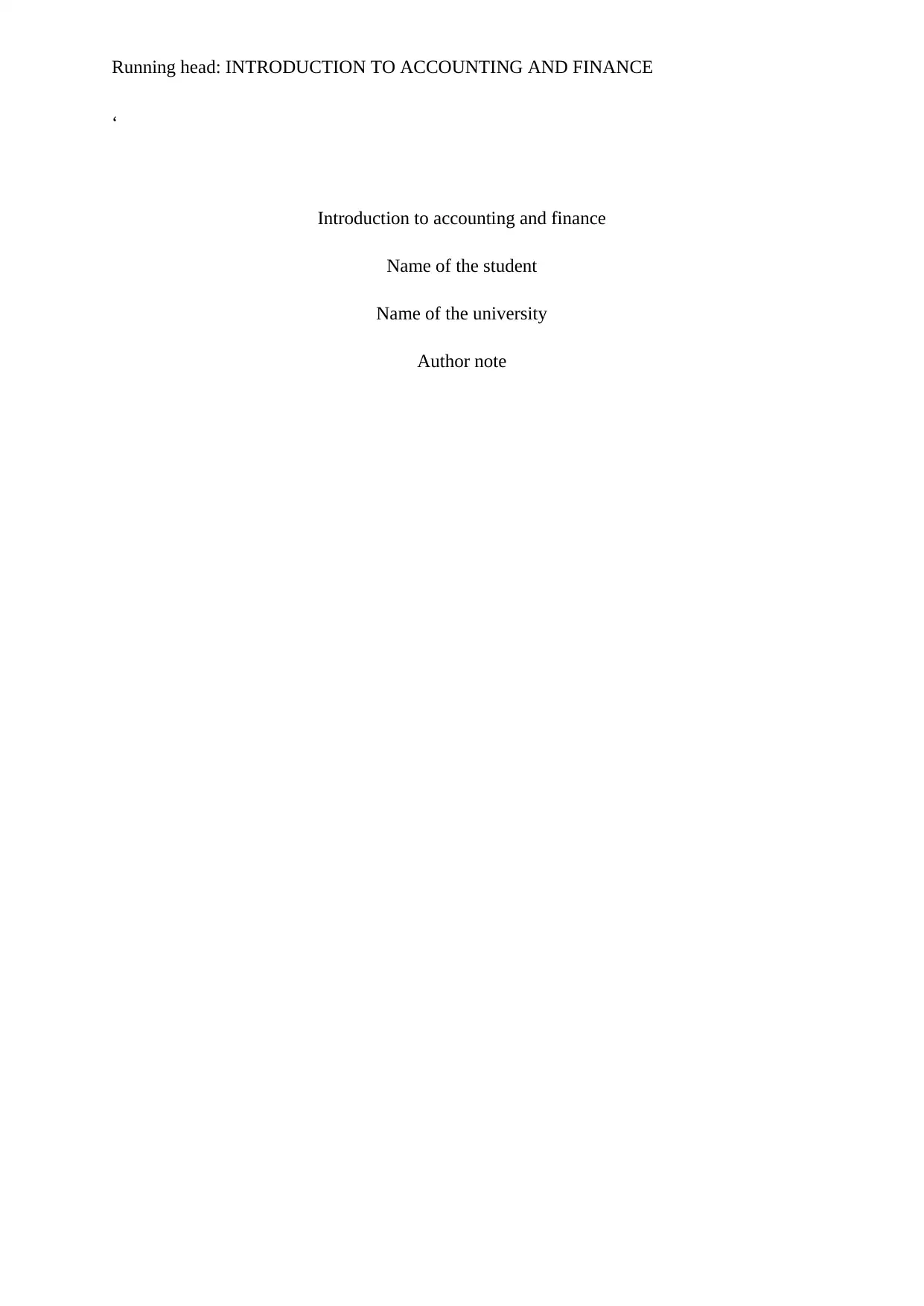
Running head: INTRODUCTION TO ACCOUNTING AND FINANCE
‘
Introduction to accounting and finance
Name of the student
Name of the university
Author note
‘
Introduction to accounting and finance
Name of the student
Name of the university
Author note
Paraphrase This Document
Need a fresh take? Get an instant paraphrase of this document with our AI Paraphraser
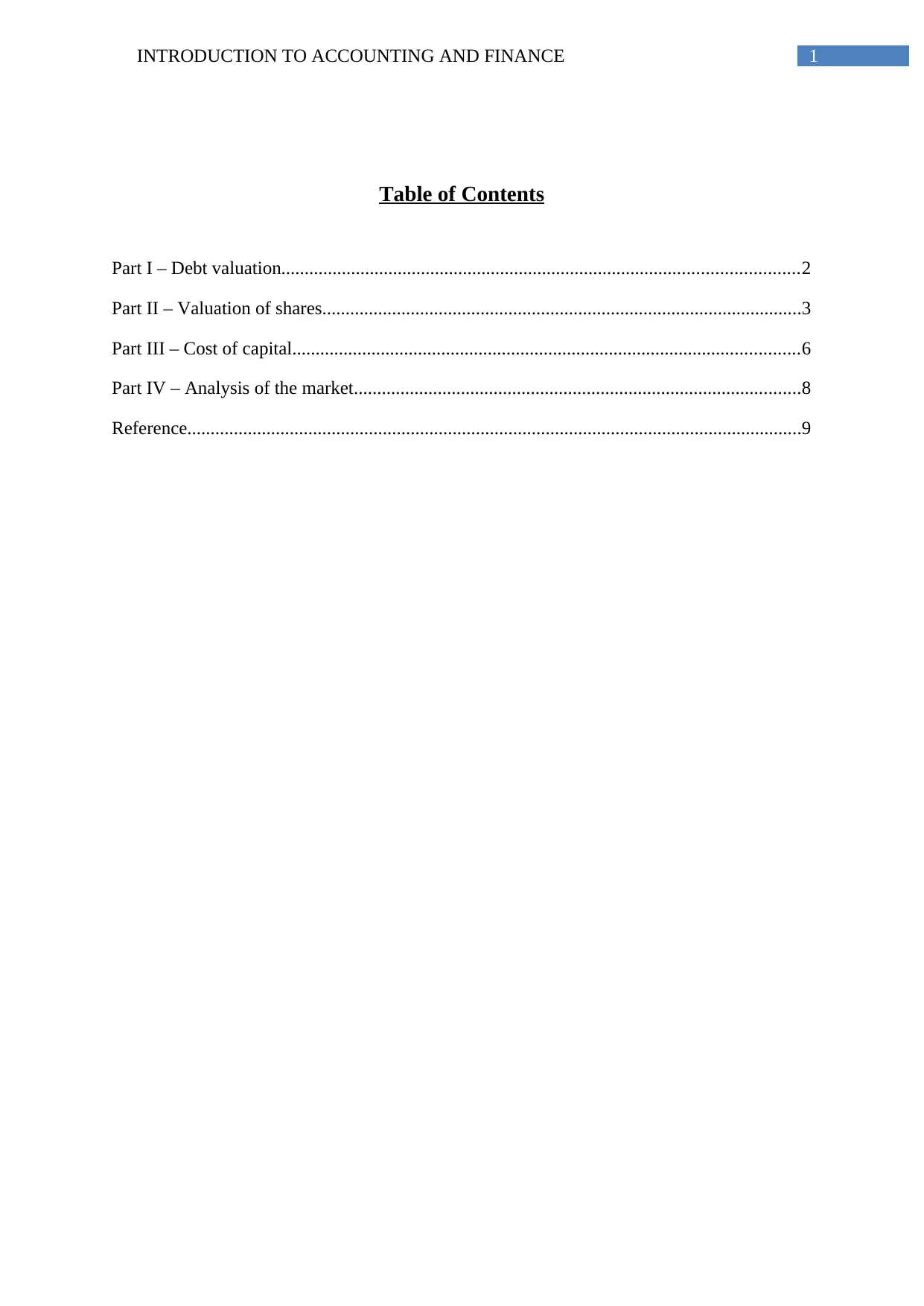
1INTRODUCTION TO ACCOUNTING AND FINANCE
Table of Contents
Part I – Debt valuation...............................................................................................................2
Part II – Valuation of shares.......................................................................................................3
Part III – Cost of capital.............................................................................................................6
Part IV – Analysis of the market................................................................................................8
Reference....................................................................................................................................9
Table of Contents
Part I – Debt valuation...............................................................................................................2
Part II – Valuation of shares.......................................................................................................3
Part III – Cost of capital.............................................................................................................6
Part IV – Analysis of the market................................................................................................8
Reference....................................................................................................................................9
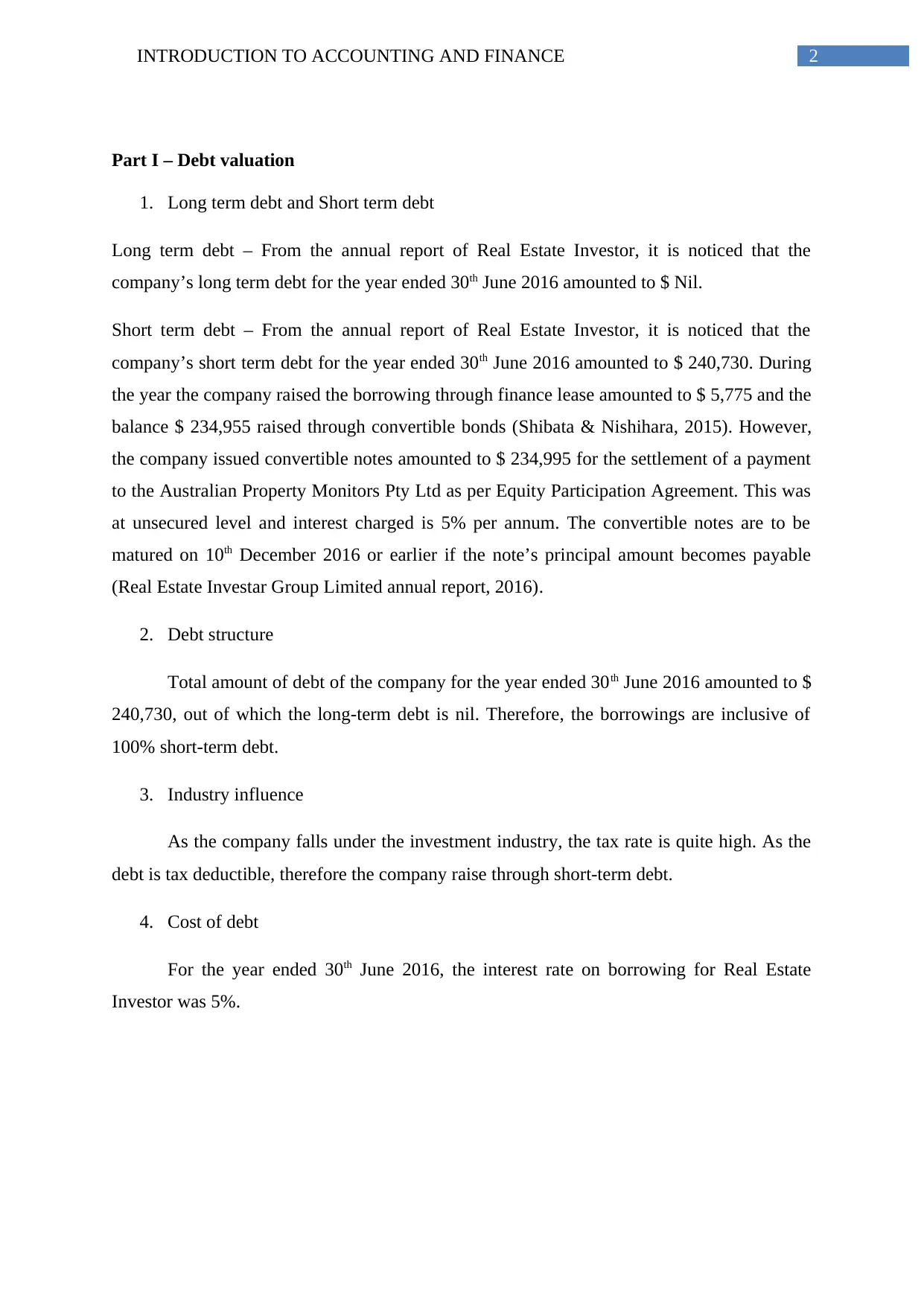
2INTRODUCTION TO ACCOUNTING AND FINANCE
Part I – Debt valuation
1. Long term debt and Short term debt
Long term debt – From the annual report of Real Estate Investor, it is noticed that the
company’s long term debt for the year ended 30th June 2016 amounted to $ Nil.
Short term debt – From the annual report of Real Estate Investor, it is noticed that the
company’s short term debt for the year ended 30th June 2016 amounted to $ 240,730. During
the year the company raised the borrowing through finance lease amounted to $ 5,775 and the
balance $ 234,955 raised through convertible bonds (Shibata & Nishihara, 2015). However,
the company issued convertible notes amounted to $ 234,995 for the settlement of a payment
to the Australian Property Monitors Pty Ltd as per Equity Participation Agreement. This was
at unsecured level and interest charged is 5% per annum. The convertible notes are to be
matured on 10th December 2016 or earlier if the note’s principal amount becomes payable
(Real Estate Investar Group Limited annual report, 2016).
2. Debt structure
Total amount of debt of the company for the year ended 30th June 2016 amounted to $
240,730, out of which the long-term debt is nil. Therefore, the borrowings are inclusive of
100% short-term debt.
3. Industry influence
As the company falls under the investment industry, the tax rate is quite high. As the
debt is tax deductible, therefore the company raise through short-term debt.
4. Cost of debt
For the year ended 30th June 2016, the interest rate on borrowing for Real Estate
Investor was 5%.
Part I – Debt valuation
1. Long term debt and Short term debt
Long term debt – From the annual report of Real Estate Investor, it is noticed that the
company’s long term debt for the year ended 30th June 2016 amounted to $ Nil.
Short term debt – From the annual report of Real Estate Investor, it is noticed that the
company’s short term debt for the year ended 30th June 2016 amounted to $ 240,730. During
the year the company raised the borrowing through finance lease amounted to $ 5,775 and the
balance $ 234,955 raised through convertible bonds (Shibata & Nishihara, 2015). However,
the company issued convertible notes amounted to $ 234,995 for the settlement of a payment
to the Australian Property Monitors Pty Ltd as per Equity Participation Agreement. This was
at unsecured level and interest charged is 5% per annum. The convertible notes are to be
matured on 10th December 2016 or earlier if the note’s principal amount becomes payable
(Real Estate Investar Group Limited annual report, 2016).
2. Debt structure
Total amount of debt of the company for the year ended 30th June 2016 amounted to $
240,730, out of which the long-term debt is nil. Therefore, the borrowings are inclusive of
100% short-term debt.
3. Industry influence
As the company falls under the investment industry, the tax rate is quite high. As the
debt is tax deductible, therefore the company raise through short-term debt.
4. Cost of debt
For the year ended 30th June 2016, the interest rate on borrowing for Real Estate
Investor was 5%.
⊘ This is a preview!⊘
Do you want full access?
Subscribe today to unlock all pages.

Trusted by 1+ million students worldwide
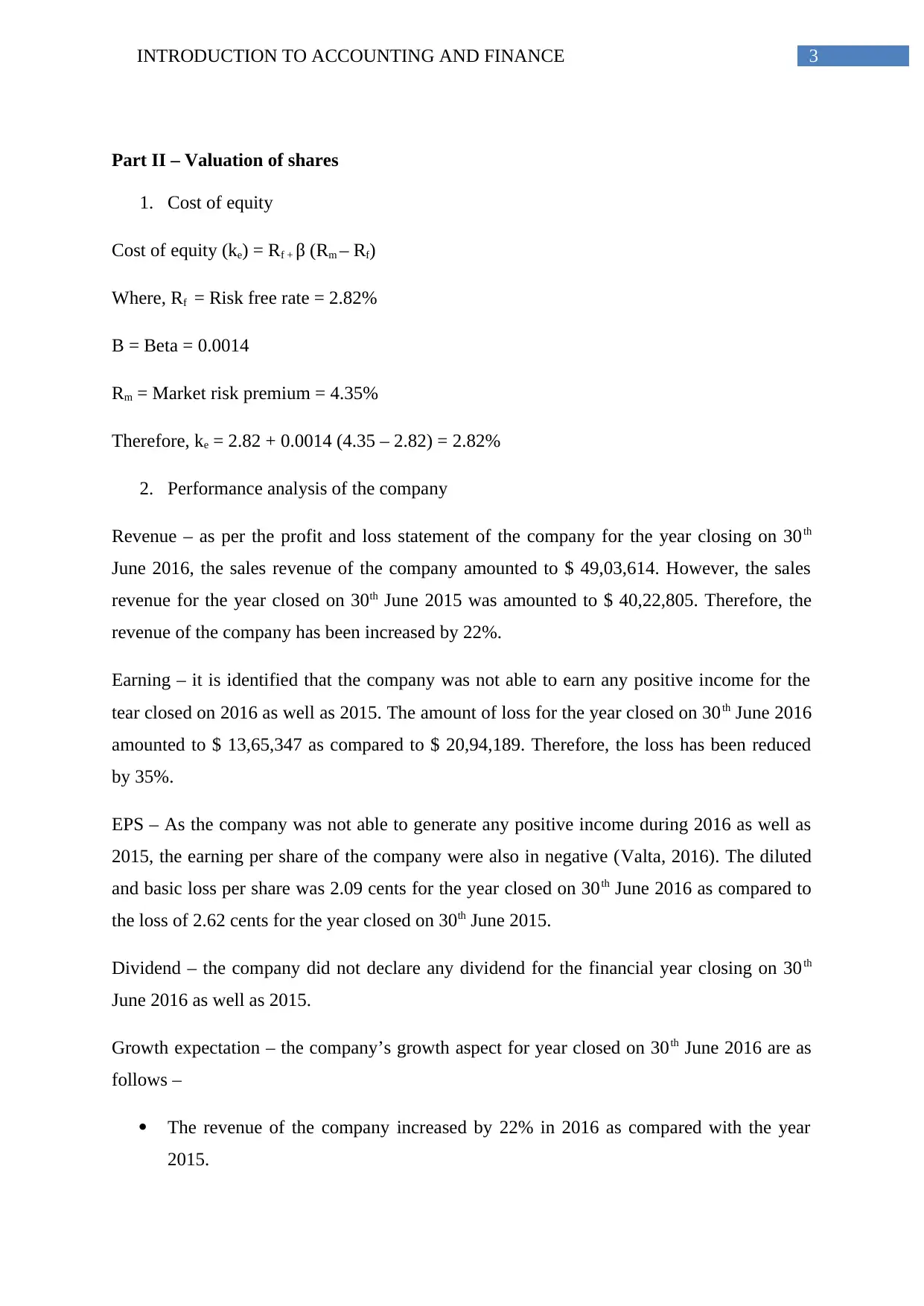
3INTRODUCTION TO ACCOUNTING AND FINANCE
Part II – Valuation of shares
1. Cost of equity
Cost of equity (ke) = Rf + β (Rm – Rf)
Where, Rf = Risk free rate = 2.82%
Β = Beta = 0.0014
Rm = Market risk premium = 4.35%
Therefore, ke = 2.82 + 0.0014 (4.35 – 2.82) = 2.82%
2. Performance analysis of the company
Revenue – as per the profit and loss statement of the company for the year closing on 30th
June 2016, the sales revenue of the company amounted to $ 49,03,614. However, the sales
revenue for the year closed on 30th June 2015 was amounted to $ 40,22,805. Therefore, the
revenue of the company has been increased by 22%.
Earning – it is identified that the company was not able to earn any positive income for the
tear closed on 2016 as well as 2015. The amount of loss for the year closed on 30th June 2016
amounted to $ 13,65,347 as compared to $ 20,94,189. Therefore, the loss has been reduced
by 35%.
EPS – As the company was not able to generate any positive income during 2016 as well as
2015, the earning per share of the company were also in negative (Valta, 2016). The diluted
and basic loss per share was 2.09 cents for the year closed on 30th June 2016 as compared to
the loss of 2.62 cents for the year closed on 30th June 2015.
Dividend – the company did not declare any dividend for the financial year closing on 30th
June 2016 as well as 2015.
Growth expectation – the company’s growth aspect for year closed on 30th June 2016 are as
follows –
The revenue of the company increased by 22% in 2016 as compared with the year
2015.
Part II – Valuation of shares
1. Cost of equity
Cost of equity (ke) = Rf + β (Rm – Rf)
Where, Rf = Risk free rate = 2.82%
Β = Beta = 0.0014
Rm = Market risk premium = 4.35%
Therefore, ke = 2.82 + 0.0014 (4.35 – 2.82) = 2.82%
2. Performance analysis of the company
Revenue – as per the profit and loss statement of the company for the year closing on 30th
June 2016, the sales revenue of the company amounted to $ 49,03,614. However, the sales
revenue for the year closed on 30th June 2015 was amounted to $ 40,22,805. Therefore, the
revenue of the company has been increased by 22%.
Earning – it is identified that the company was not able to earn any positive income for the
tear closed on 2016 as well as 2015. The amount of loss for the year closed on 30th June 2016
amounted to $ 13,65,347 as compared to $ 20,94,189. Therefore, the loss has been reduced
by 35%.
EPS – As the company was not able to generate any positive income during 2016 as well as
2015, the earning per share of the company were also in negative (Valta, 2016). The diluted
and basic loss per share was 2.09 cents for the year closed on 30th June 2016 as compared to
the loss of 2.62 cents for the year closed on 30th June 2015.
Dividend – the company did not declare any dividend for the financial year closing on 30th
June 2016 as well as 2015.
Growth expectation – the company’s growth aspect for year closed on 30th June 2016 are as
follows –
The revenue of the company increased by 22% in 2016 as compared with the year
2015.
Paraphrase This Document
Need a fresh take? Get an instant paraphrase of this document with our AI Paraphraser
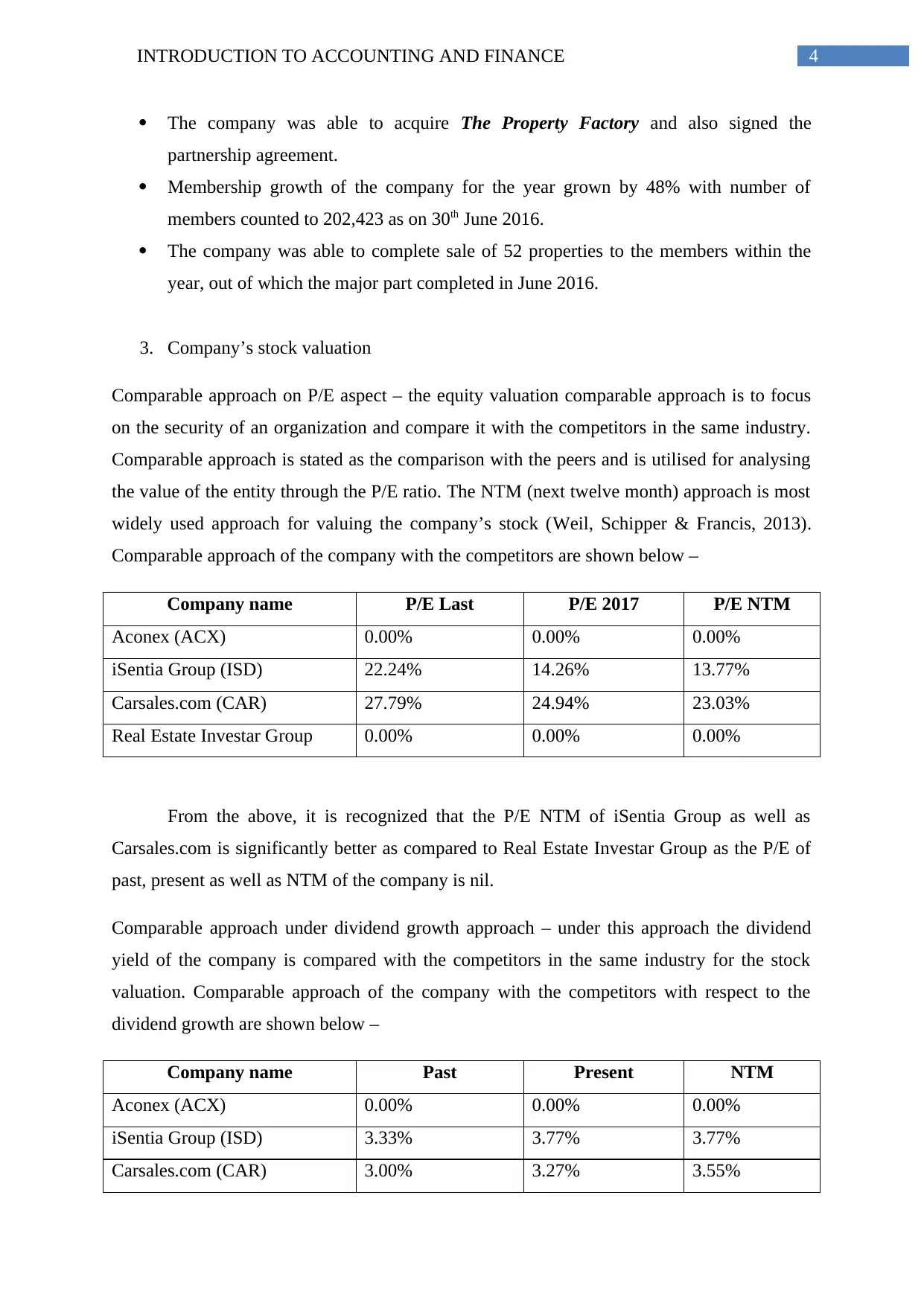
4INTRODUCTION TO ACCOUNTING AND FINANCE
The company was able to acquire The Property Factory and also signed the
partnership agreement.
Membership growth of the company for the year grown by 48% with number of
members counted to 202,423 as on 30th June 2016.
The company was able to complete sale of 52 properties to the members within the
year, out of which the major part completed in June 2016.
3. Company’s stock valuation
Comparable approach on P/E aspect – the equity valuation comparable approach is to focus
on the security of an organization and compare it with the competitors in the same industry.
Comparable approach is stated as the comparison with the peers and is utilised for analysing
the value of the entity through the P/E ratio. The NTM (next twelve month) approach is most
widely used approach for valuing the company’s stock (Weil, Schipper & Francis, 2013).
Comparable approach of the company with the competitors are shown below –
Company name P/E Last P/E 2017 P/E NTM
Aconex (ACX) 0.00% 0.00% 0.00%
iSentia Group (ISD) 22.24% 14.26% 13.77%
Carsales.com (CAR) 27.79% 24.94% 23.03%
Real Estate Investar Group 0.00% 0.00% 0.00%
From the above, it is recognized that the P/E NTM of iSentia Group as well as
Carsales.com is significantly better as compared to Real Estate Investar Group as the P/E of
past, present as well as NTM of the company is nil.
Comparable approach under dividend growth approach – under this approach the dividend
yield of the company is compared with the competitors in the same industry for the stock
valuation. Comparable approach of the company with the competitors with respect to the
dividend growth are shown below –
Company name Past Present NTM
Aconex (ACX) 0.00% 0.00% 0.00%
iSentia Group (ISD) 3.33% 3.77% 3.77%
Carsales.com (CAR) 3.00% 3.27% 3.55%
The company was able to acquire The Property Factory and also signed the
partnership agreement.
Membership growth of the company for the year grown by 48% with number of
members counted to 202,423 as on 30th June 2016.
The company was able to complete sale of 52 properties to the members within the
year, out of which the major part completed in June 2016.
3. Company’s stock valuation
Comparable approach on P/E aspect – the equity valuation comparable approach is to focus
on the security of an organization and compare it with the competitors in the same industry.
Comparable approach is stated as the comparison with the peers and is utilised for analysing
the value of the entity through the P/E ratio. The NTM (next twelve month) approach is most
widely used approach for valuing the company’s stock (Weil, Schipper & Francis, 2013).
Comparable approach of the company with the competitors are shown below –
Company name P/E Last P/E 2017 P/E NTM
Aconex (ACX) 0.00% 0.00% 0.00%
iSentia Group (ISD) 22.24% 14.26% 13.77%
Carsales.com (CAR) 27.79% 24.94% 23.03%
Real Estate Investar Group 0.00% 0.00% 0.00%
From the above, it is recognized that the P/E NTM of iSentia Group as well as
Carsales.com is significantly better as compared to Real Estate Investar Group as the P/E of
past, present as well as NTM of the company is nil.
Comparable approach under dividend growth approach – under this approach the dividend
yield of the company is compared with the competitors in the same industry for the stock
valuation. Comparable approach of the company with the competitors with respect to the
dividend growth are shown below –
Company name Past Present NTM
Aconex (ACX) 0.00% 0.00% 0.00%
iSentia Group (ISD) 3.33% 3.77% 3.77%
Carsales.com (CAR) 3.00% 3.27% 3.55%
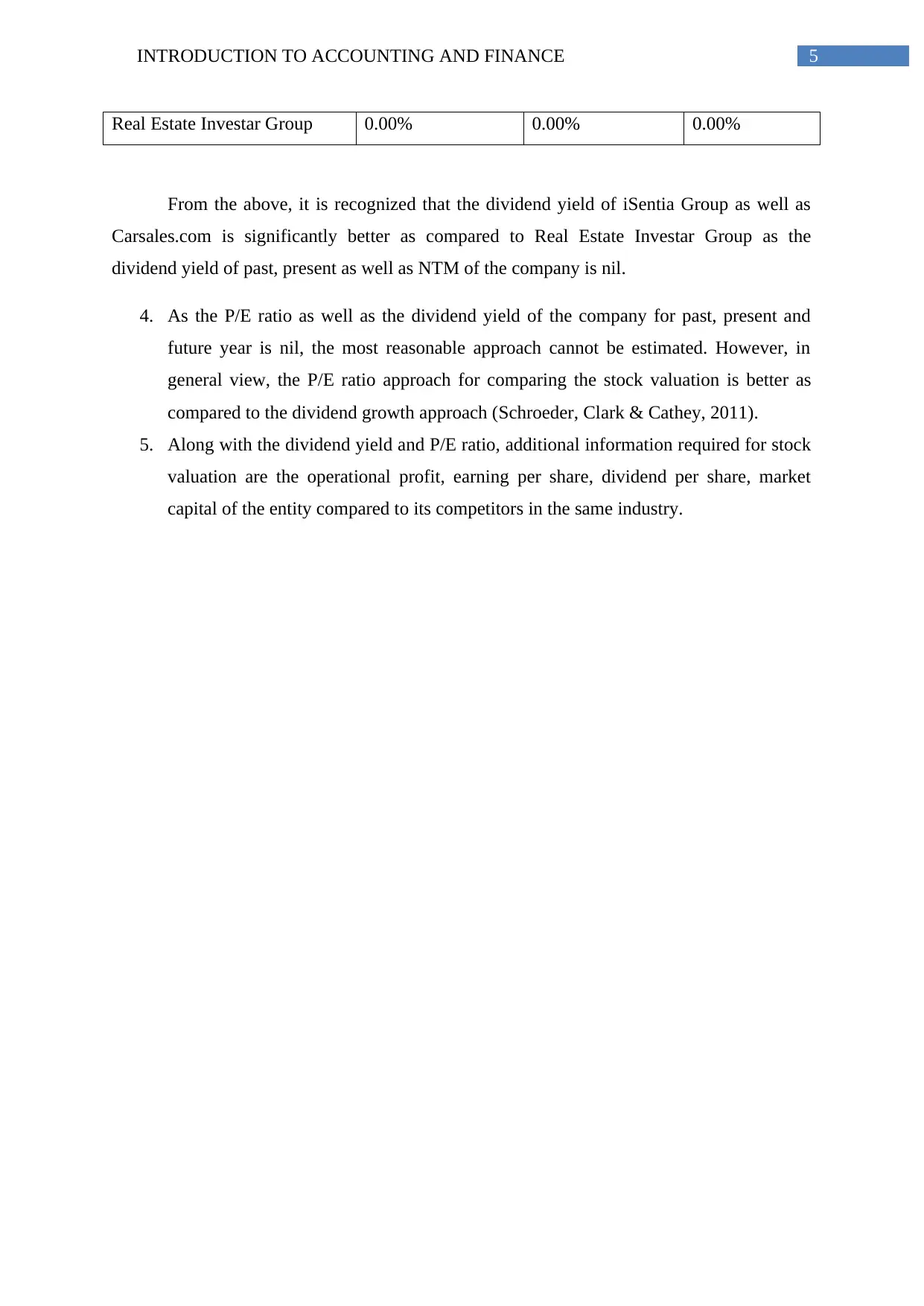
5INTRODUCTION TO ACCOUNTING AND FINANCE
Real Estate Investar Group 0.00% 0.00% 0.00%
From the above, it is recognized that the dividend yield of iSentia Group as well as
Carsales.com is significantly better as compared to Real Estate Investar Group as the
dividend yield of past, present as well as NTM of the company is nil.
4. As the P/E ratio as well as the dividend yield of the company for past, present and
future year is nil, the most reasonable approach cannot be estimated. However, in
general view, the P/E ratio approach for comparing the stock valuation is better as
compared to the dividend growth approach (Schroeder, Clark & Cathey, 2011).
5. Along with the dividend yield and P/E ratio, additional information required for stock
valuation are the operational profit, earning per share, dividend per share, market
capital of the entity compared to its competitors in the same industry.
Real Estate Investar Group 0.00% 0.00% 0.00%
From the above, it is recognized that the dividend yield of iSentia Group as well as
Carsales.com is significantly better as compared to Real Estate Investar Group as the
dividend yield of past, present as well as NTM of the company is nil.
4. As the P/E ratio as well as the dividend yield of the company for past, present and
future year is nil, the most reasonable approach cannot be estimated. However, in
general view, the P/E ratio approach for comparing the stock valuation is better as
compared to the dividend growth approach (Schroeder, Clark & Cathey, 2011).
5. Along with the dividend yield and P/E ratio, additional information required for stock
valuation are the operational profit, earning per share, dividend per share, market
capital of the entity compared to its competitors in the same industry.
⊘ This is a preview!⊘
Do you want full access?
Subscribe today to unlock all pages.

Trusted by 1+ million students worldwide
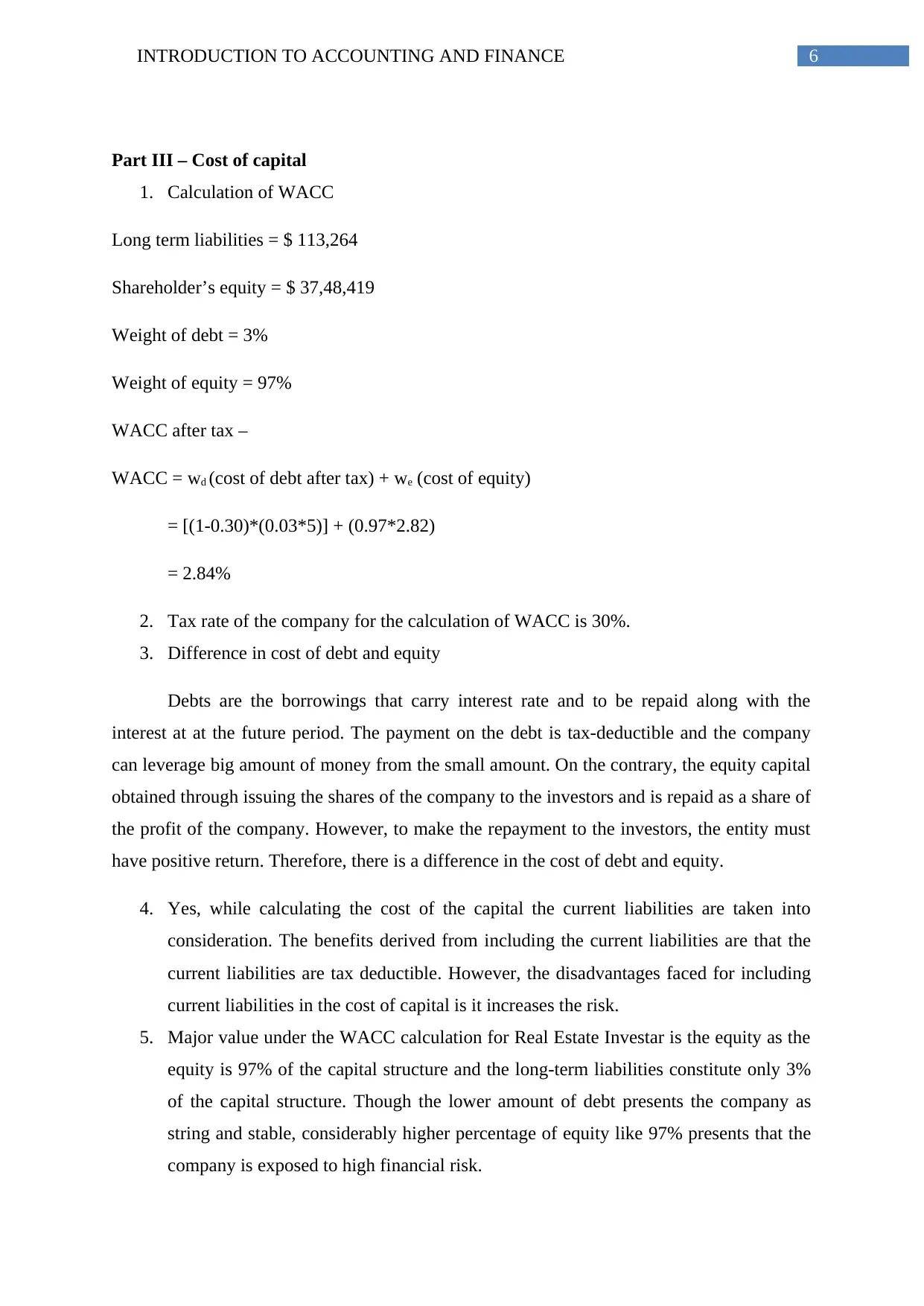
6INTRODUCTION TO ACCOUNTING AND FINANCE
Part III – Cost of capital
1. Calculation of WACC
Long term liabilities = $ 113,264
Shareholder’s equity = $ 37,48,419
Weight of debt = 3%
Weight of equity = 97%
WACC after tax –
WACC = wd (cost of debt after tax) + we (cost of equity)
= [(1-0.30)*(0.03*5)] + (0.97*2.82)
= 2.84%
2. Tax rate of the company for the calculation of WACC is 30%.
3. Difference in cost of debt and equity
Debts are the borrowings that carry interest rate and to be repaid along with the
interest at at the future period. The payment on the debt is tax-deductible and the company
can leverage big amount of money from the small amount. On the contrary, the equity capital
obtained through issuing the shares of the company to the investors and is repaid as a share of
the profit of the company. However, to make the repayment to the investors, the entity must
have positive return. Therefore, there is a difference in the cost of debt and equity.
4. Yes, while calculating the cost of the capital the current liabilities are taken into
consideration. The benefits derived from including the current liabilities are that the
current liabilities are tax deductible. However, the disadvantages faced for including
current liabilities in the cost of capital is it increases the risk.
5. Major value under the WACC calculation for Real Estate Investar is the equity as the
equity is 97% of the capital structure and the long-term liabilities constitute only 3%
of the capital structure. Though the lower amount of debt presents the company as
string and stable, considerably higher percentage of equity like 97% presents that the
company is exposed to high financial risk.
Part III – Cost of capital
1. Calculation of WACC
Long term liabilities = $ 113,264
Shareholder’s equity = $ 37,48,419
Weight of debt = 3%
Weight of equity = 97%
WACC after tax –
WACC = wd (cost of debt after tax) + we (cost of equity)
= [(1-0.30)*(0.03*5)] + (0.97*2.82)
= 2.84%
2. Tax rate of the company for the calculation of WACC is 30%.
3. Difference in cost of debt and equity
Debts are the borrowings that carry interest rate and to be repaid along with the
interest at at the future period. The payment on the debt is tax-deductible and the company
can leverage big amount of money from the small amount. On the contrary, the equity capital
obtained through issuing the shares of the company to the investors and is repaid as a share of
the profit of the company. However, to make the repayment to the investors, the entity must
have positive return. Therefore, there is a difference in the cost of debt and equity.
4. Yes, while calculating the cost of the capital the current liabilities are taken into
consideration. The benefits derived from including the current liabilities are that the
current liabilities are tax deductible. However, the disadvantages faced for including
current liabilities in the cost of capital is it increases the risk.
5. Major value under the WACC calculation for Real Estate Investar is the equity as the
equity is 97% of the capital structure and the long-term liabilities constitute only 3%
of the capital structure. Though the lower amount of debt presents the company as
string and stable, considerably higher percentage of equity like 97% presents that the
company is exposed to high financial risk.
Paraphrase This Document
Need a fresh take? Get an instant paraphrase of this document with our AI Paraphraser
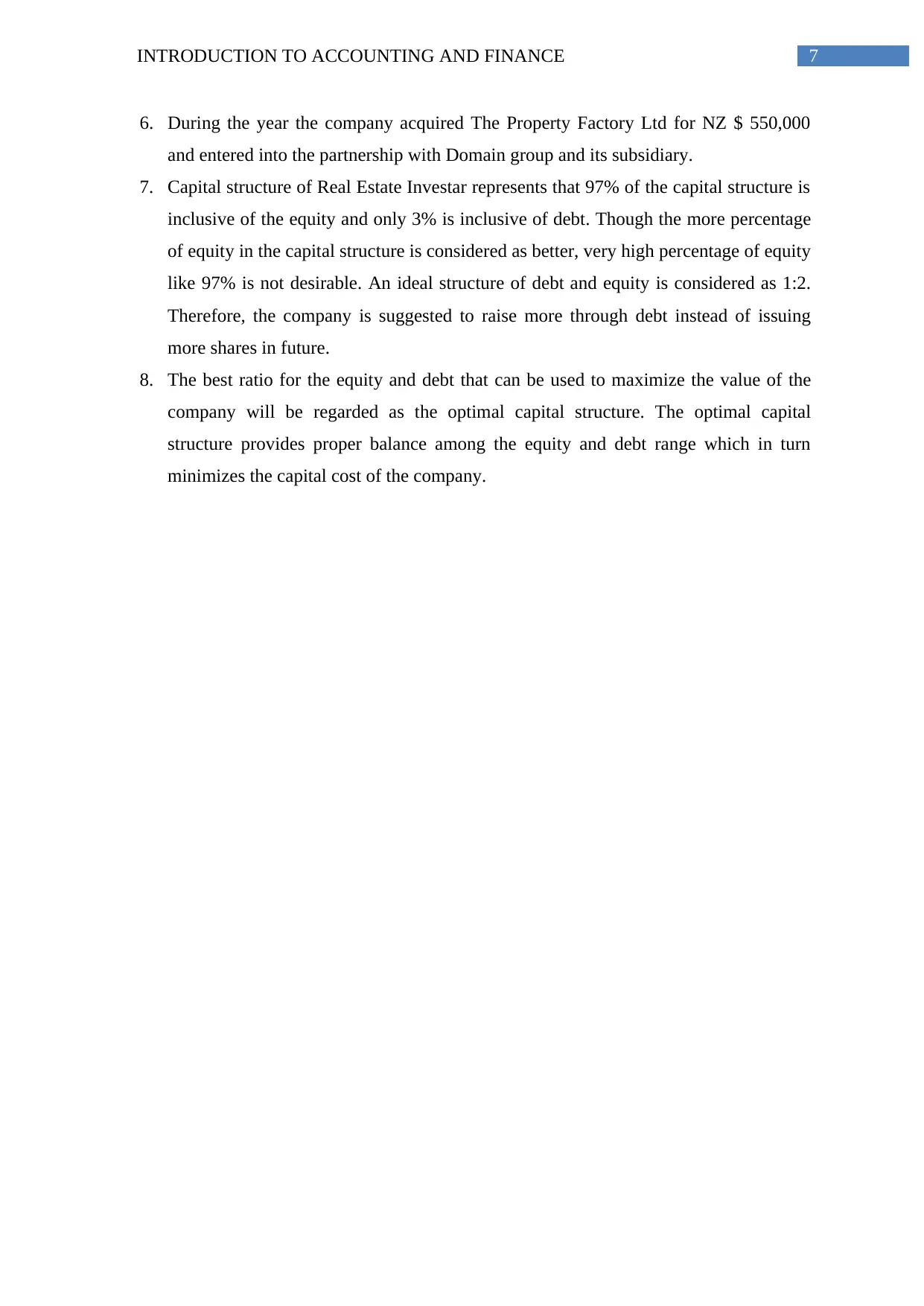
7INTRODUCTION TO ACCOUNTING AND FINANCE
6. During the year the company acquired The Property Factory Ltd for NZ $ 550,000
and entered into the partnership with Domain group and its subsidiary.
7. Capital structure of Real Estate Investar represents that 97% of the capital structure is
inclusive of the equity and only 3% is inclusive of debt. Though the more percentage
of equity in the capital structure is considered as better, very high percentage of equity
like 97% is not desirable. An ideal structure of debt and equity is considered as 1:2.
Therefore, the company is suggested to raise more through debt instead of issuing
more shares in future.
8. The best ratio for the equity and debt that can be used to maximize the value of the
company will be regarded as the optimal capital structure. The optimal capital
structure provides proper balance among the equity and debt range which in turn
minimizes the capital cost of the company.
6. During the year the company acquired The Property Factory Ltd for NZ $ 550,000
and entered into the partnership with Domain group and its subsidiary.
7. Capital structure of Real Estate Investar represents that 97% of the capital structure is
inclusive of the equity and only 3% is inclusive of debt. Though the more percentage
of equity in the capital structure is considered as better, very high percentage of equity
like 97% is not desirable. An ideal structure of debt and equity is considered as 1:2.
Therefore, the company is suggested to raise more through debt instead of issuing
more shares in future.
8. The best ratio for the equity and debt that can be used to maximize the value of the
company will be regarded as the optimal capital structure. The optimal capital
structure provides proper balance among the equity and debt range which in turn
minimizes the capital cost of the company.
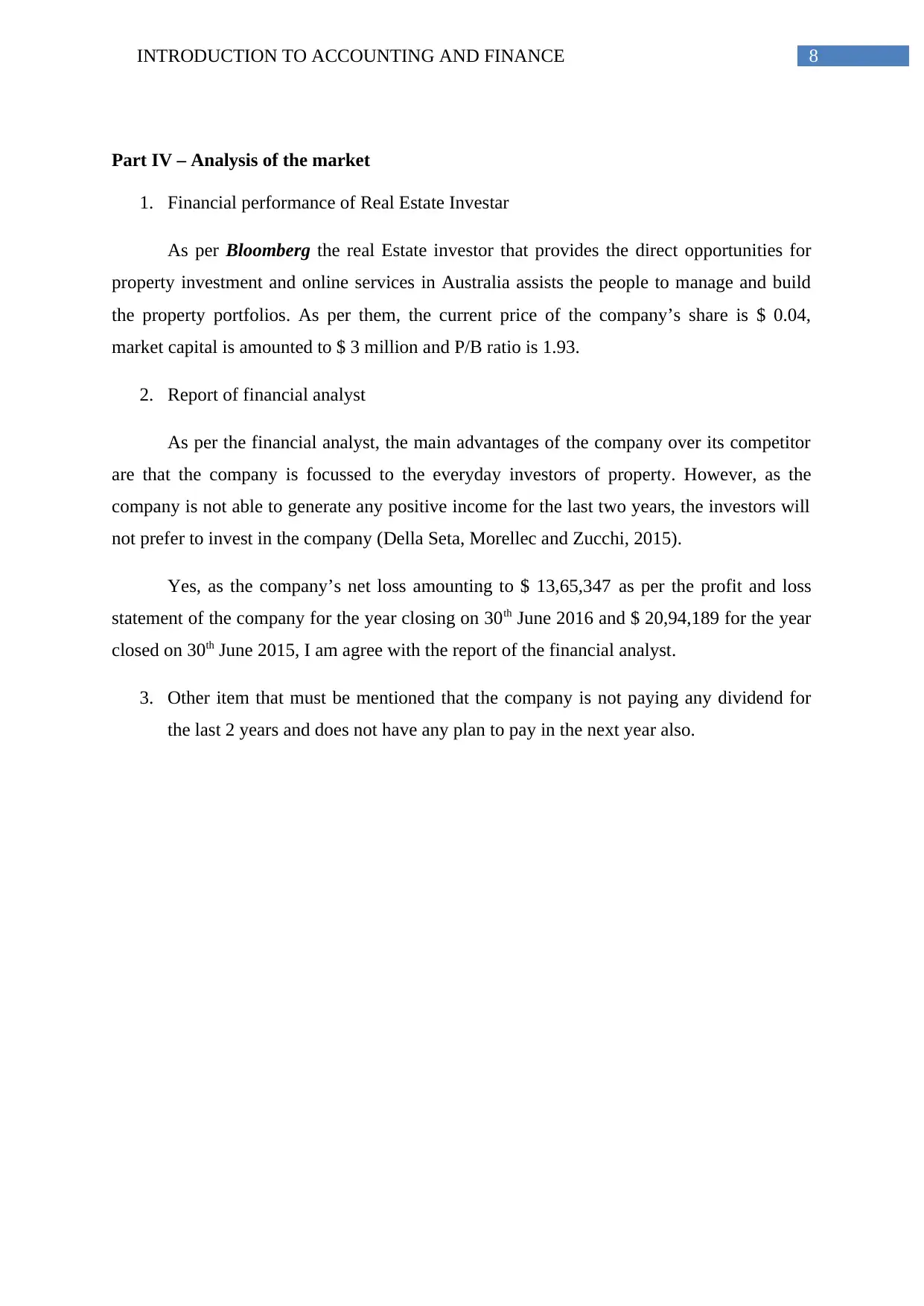
8INTRODUCTION TO ACCOUNTING AND FINANCE
Part IV – Analysis of the market
1. Financial performance of Real Estate Investar
As per Bloomberg the real Estate investor that provides the direct opportunities for
property investment and online services in Australia assists the people to manage and build
the property portfolios. As per them, the current price of the company’s share is $ 0.04,
market capital is amounted to $ 3 million and P/B ratio is 1.93.
2. Report of financial analyst
As per the financial analyst, the main advantages of the company over its competitor
are that the company is focussed to the everyday investors of property. However, as the
company is not able to generate any positive income for the last two years, the investors will
not prefer to invest in the company (Della Seta, Morellec and Zucchi, 2015).
Yes, as the company’s net loss amounting to $ 13,65,347 as per the profit and loss
statement of the company for the year closing on 30th June 2016 and $ 20,94,189 for the year
closed on 30th June 2015, I am agree with the report of the financial analyst.
3. Other item that must be mentioned that the company is not paying any dividend for
the last 2 years and does not have any plan to pay in the next year also.
Part IV – Analysis of the market
1. Financial performance of Real Estate Investar
As per Bloomberg the real Estate investor that provides the direct opportunities for
property investment and online services in Australia assists the people to manage and build
the property portfolios. As per them, the current price of the company’s share is $ 0.04,
market capital is amounted to $ 3 million and P/B ratio is 1.93.
2. Report of financial analyst
As per the financial analyst, the main advantages of the company over its competitor
are that the company is focussed to the everyday investors of property. However, as the
company is not able to generate any positive income for the last two years, the investors will
not prefer to invest in the company (Della Seta, Morellec and Zucchi, 2015).
Yes, as the company’s net loss amounting to $ 13,65,347 as per the profit and loss
statement of the company for the year closing on 30th June 2016 and $ 20,94,189 for the year
closed on 30th June 2015, I am agree with the report of the financial analyst.
3. Other item that must be mentioned that the company is not paying any dividend for
the last 2 years and does not have any plan to pay in the next year also.
⊘ This is a preview!⊘
Do you want full access?
Subscribe today to unlock all pages.

Trusted by 1+ million students worldwide
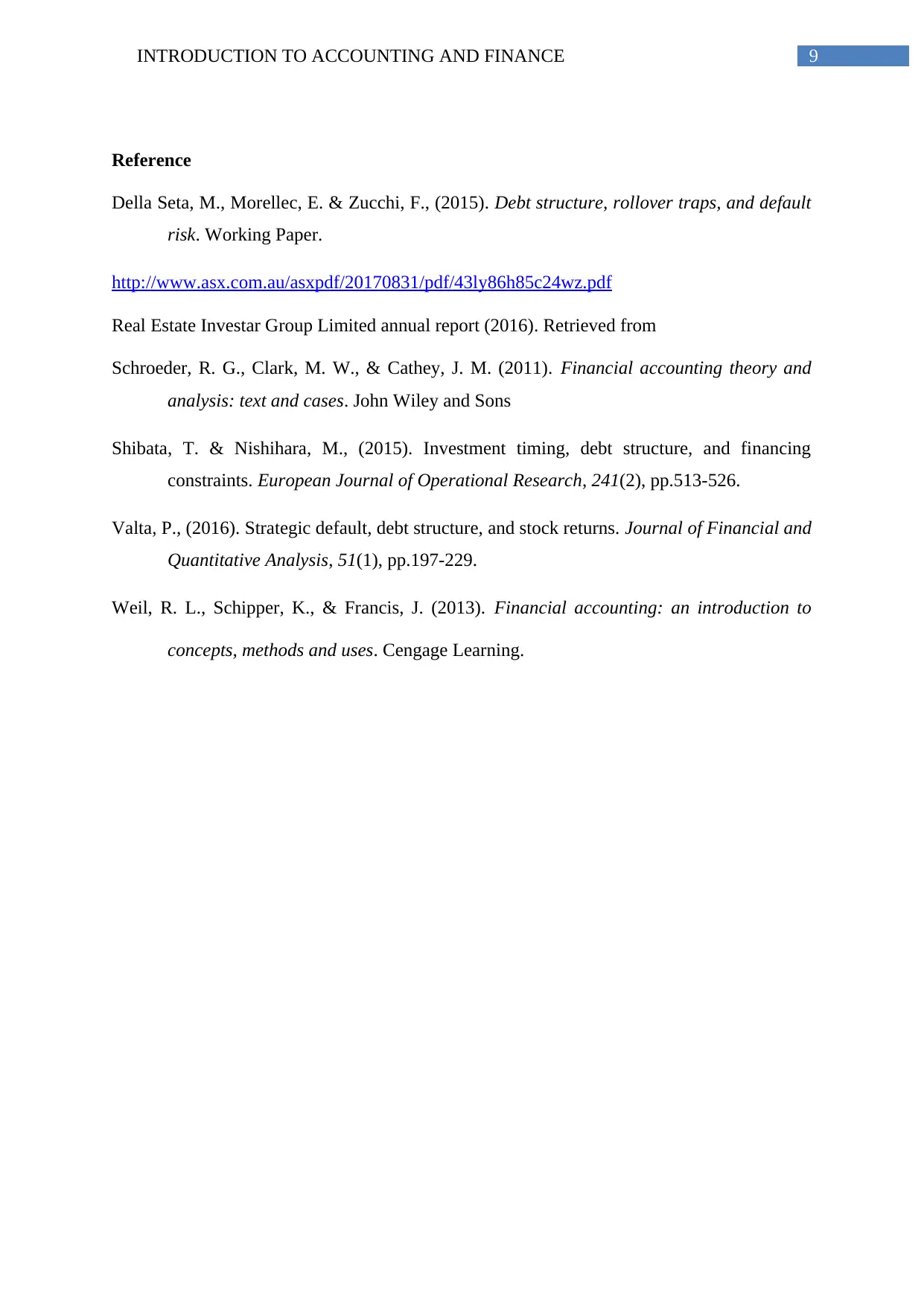
9INTRODUCTION TO ACCOUNTING AND FINANCE
Reference
Della Seta, M., Morellec, E. & Zucchi, F., (2015). Debt structure, rollover traps, and default
risk. Working Paper.
http://www.asx.com.au/asxpdf/20170831/pdf/43ly86h85c24wz.pdf
Real Estate Investar Group Limited annual report (2016). Retrieved from
Schroeder, R. G., Clark, M. W., & Cathey, J. M. (2011). Financial accounting theory and
analysis: text and cases. John Wiley and Sons
Shibata, T. & Nishihara, M., (2015). Investment timing, debt structure, and financing
constraints. European Journal of Operational Research, 241(2), pp.513-526.
Valta, P., (2016). Strategic default, debt structure, and stock returns. Journal of Financial and
Quantitative Analysis, 51(1), pp.197-229.
Weil, R. L., Schipper, K., & Francis, J. (2013). Financial accounting: an introduction to
concepts, methods and uses. Cengage Learning.
Reference
Della Seta, M., Morellec, E. & Zucchi, F., (2015). Debt structure, rollover traps, and default
risk. Working Paper.
http://www.asx.com.au/asxpdf/20170831/pdf/43ly86h85c24wz.pdf
Real Estate Investar Group Limited annual report (2016). Retrieved from
Schroeder, R. G., Clark, M. W., & Cathey, J. M. (2011). Financial accounting theory and
analysis: text and cases. John Wiley and Sons
Shibata, T. & Nishihara, M., (2015). Investment timing, debt structure, and financing
constraints. European Journal of Operational Research, 241(2), pp.513-526.
Valta, P., (2016). Strategic default, debt structure, and stock returns. Journal of Financial and
Quantitative Analysis, 51(1), pp.197-229.
Weil, R. L., Schipper, K., & Francis, J. (2013). Financial accounting: an introduction to
concepts, methods and uses. Cengage Learning.
1 out of 10
Related Documents
Your All-in-One AI-Powered Toolkit for Academic Success.
+13062052269
info@desklib.com
Available 24*7 on WhatsApp / Email
![[object Object]](/_next/static/media/star-bottom.7253800d.svg)
Unlock your academic potential
Copyright © 2020–2025 A2Z Services. All Rights Reserved. Developed and managed by ZUCOL.



